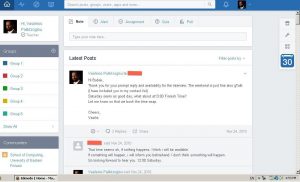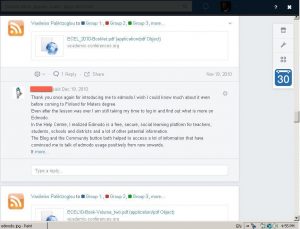Description
With the rapid growth of technologies and the appearance of social media the potential of technology-supported PBL seems significant, since it can be used to enrich interactions between students and reduce the time constraints of the traditional classroom. Social media tools are used in many institutions for educational purposes in numerous, innovative ways even to the extent of such tools being utilized in traditional face-to-face classrooms. Of particular note is that the revised Bloom’s taxonomy of educational objectives (Anderson & Krathwohl, 2001) has been extended to include the relevant terminology describing the learning process through the use of social media tools, which indicates the adoption of such tools in modern education.
Link to example artifact(s)
Use Facebook to support group work in an eMarketing course

In this blended course taught by Vasileios Paliktzoglou (Bahrain Polytechnic) the focus was on the students’ engagement with Facebook as an assisted learning tool in problem-based learning (PBL) settings. A cohort of web media students participated in an eMarketing course. The students used Facebook in their PBL group work assignment developing a social media strategy for a fictional company. Following the PBL structure four teams of four to six students worked together to solve problems and apply concepts learned during the course.

Facebook was used to promote and extend the team interactions online and outside of the physical classroom. The students had a general introduction to social media tools and more specifically Facebook where they were provided with instructions how to use the tool through set of practical tasks. Then in groups of five to six students started working with Facebook and becoming familiar with Social media through their PBL assignment. Moreover, all the lecturing material that was in the form of articles, books, podcast and RSS, beyond the general instructions about how the course works, were given in Moodle and the rest of the course material was provide in the Facebook. It is worth mentioning that the instructor in his role as facilitator was constantly supporting, stimulating and facilitating collaboration on a day-to-day basis. Part of the learning strategy was to motivate students to collaborate, share resources and discuss their work in Facebook. For example, each of the students had to post at least three posts per/week related to their topic, as part of the collaboration process, and then reply to posts from colleagues. These way students were active participants in Facebook and participation was rewarded as part of the course marks. Integrating the strengths of social media tools such as Facebook, is a forthcoming way to effectively facilitate PBL. With the use of social media, students can share information, negotiate ideas and work cooperatively. Additionally, the learning process can be automatically recorded by the instructor knowing what tasks have been completed, and what else needs to be done. This way the instructor can assure the successful completion of the learning process.
For example, each of the students had to post at least three posts per/week related to their topic, as part of the collaboration process, and then reply to posts from colleagues. These way students were active participants in Facebook and participation was rewarded as part of the course marks. The students positively suggested the use of Facebook in other courses with PBL curriculum. The reception of a Facebook as an educational tool to support PBL was generally positive as indicated by students. The instructor had the role of a facilitator, responsible for creating an atmosphere that enhances independent learning. Nevertheless the groups’ dynamics played an important role when using Facebook and this was vital toward the students’ positive or negative reception. Additionally, we argue that in order to increase the adoption of Facebook in higher education and more specifically in PBL context, a certain emphasis on the educational side of the platform should be enhanced.
Use Edmodo to support group work in a Computer Science course

The Edmodo microblogging tool was introduced as a platform to support group work in one of the course modules during the Technologies for Development and Education online course taught by Vasileios Paliktzoglou at the School of Computing, University of Eastern Finland. Edmodo is a social learning platform that provides educators’ means for connecting, collaborations, sharing content and accessing homework, grades and school notices. Edmodo uses the micro-blogging model with main focus on education, and it is accessbible from any mobile device or smart phone. Edmodo was used alongside Moodle to support specifically the collaborative work of the students during the specific module of the course that focused on the topic of social media in education.

In the beginning of the module, the students had a general introduction to Social media technology and more specifically Edmodo where they were provided instructions how to use the tool trough set of practical tasks. Then in groups of five students start working with Edmodo and becoming familiar with Social media trough their assignments. The students were informed that lately there has been a strong drive in developing and enhancing social media technology for e/m-learning purposes. Moreover, it was discussed that social media technologies could meet many of those needs, but also brings along new challenges. During the course module students got acquainted/trained with the social media technologies and they needed to reflect and discuss upon the potential of social media technologies used for e/m-learning purposes. Subsequently they were given a short training in order to learn how to use Edmodo system though video tutorials and practical tasks. Then student had to create their groups (five) according to the interest in working the following outlined assignment topics: 1) Social bookmarking and RSS in CS/HE, 2) The use of Blogs in CS/HE, 3) The use of Wikis – Microblogging in CS/HE, 4) Podcasts in CS/HE, 5) Social software (networking) – Virtual words in CS/HE.
All the lecturing material in the form of articles, books, podcast and RSS was provided in the Edmodo. It is worth mentioning that the instructor was constantly supporting, stimulating and facilitating collaboration on a day to day basis. Part of the learning strategy was to motivate student to collaborate, share resources and discuss their work in Edmodo. As part of the collaboration process, each of the students had to post at least 3 post per/week related to the topic of their group, and hen reply to posts from colleagues. The active participation in Edmodo was a requirement for students to pass the course module. The role of the instructor was to constantly trigger the work of the student groups in the form of microblogging posts including videos, links to books articles etc. In addition, the the group forum was constantly feed with several related source using the RSS feature in Edmodo.
Link to scholarly reference(s)
Anderson, L. W., & D. Krathwohl (Eds.) (2001). A taxonomy for learning, teaching and assessing: a revision of Bloom’s taxonomy of educational objectives. Longman, New York.
Paliktzoglou, V., & Suhonen, J. (2014). Facebook as an assisted learning tool in problem-based learning: the Bahrain case. International Journal Social Media and Interactive Learning Environments, 2(1), pp.85–100.
Paliktzoglou, V., & Suhonen, J. (2014) Microblogging in higher education: The Edmodo case study among Computer Science learners in Finland Journal of Cases on Information Technology 16(2). 39-57.
Paliktzoglou, V., & Suhonen, J. (2015). Microblogging as an assisted learning tool in Problem Based Learning (PBL) in Bahrain: The Edmodo case. Manuscript submitted for publication. In Cipolla-Ficarra, F. V. Handbook of Research on Interactive Information Quality in Expanding Social Network Communications (pp. 189-207). Hershey, PA: IGI Global. https://doi.org/10.4018/978-1-4666-7377-9
Citation
Paliktzoglou, V. (2015). Use social networking tools to facilitate small group problem-based learning. In B. Chen & K. Thompson (Eds.), Teaching Online Pedagogical Repository. Orlando, FL: University of Central Florida Center for Distributed Learning. https://topr.online.ucf.edu/use-social-networking-tools-to-facilitate-small-group-problem-based-learning/.